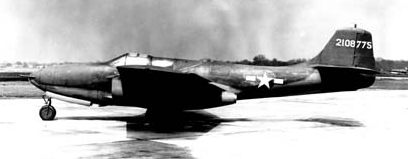
|
John A. Weeks III
Friday, January 9, 2026, 2:03:03 AM CST |
|||
| Home | Photo Tours | Rail Fan | 12 Easy Steps |
| Aviation | Spacecraft | Highways & Bridges | About The Author |

|
|
|||||||||||||||||
P-59 — The Airacomet Survivors
A British chap, Sir Frank Whittle, registered the first patent for a
jet engine designed to power an aircraft in 1930. Whittle developed
the jet engine in secret during the 1930's with support from the Royal
Air Force and British industry. The Gloster Aircraft company was selected
to build the aircraft that would test the first jet engine. The Gloster
E-28/39 finally flew on May 15, 1941. The E-28/39, also known as the
Pioneer, was eventually developed into a twin engine jet fighter called
the Meteor. The Meteor was used sparingly in WWII to avoid having the
super-secret jet engine fall into German hands.
Ironically, the Germans were already well aware of the jet engine. Hans Von Ohain had independently invented the jet engine in the mid-1930's, with the first flight of the jet-powered Heinkel He-178 on August 27, 1939. The German war machine fielded a number of jet aircraft later in the war, with several hundred of the Me-262 fighters being used in combat.

Photo courtesy of US Air Force. The USAAF learned of the Whittle jet engine in 1941, and arranged to get an example for study. General Electric was enlisted to build this engine under license. Bell Aircraft, which was noted for submitting unorthodox aircraft designs, was selected to build the first aircraft powered by the Whittle jet engine. Bell was already working on a new aircraft program called the XP-59. The USAAF designated the jet project as XP-59A in hopes of confusing anyone who learned of the project, and to use the existing Bell project as a cover story. The USAAF soon lost interest in the XP-59 project, and it faded away. Three XP-59A were placed on order, along with 15 GE I-1 jet engines. The aircraft that emerged was relatively conventional. It had straight wings mounted about mid-height on the fuselage. A high T-tail ensured that the tail would not interfere with the airflow from the engines. Not having an engine in the nose allowed the front landing gear to retract into the nose, which also housed the proposed guns and ammunition. The engines would be housed in pods under the wings adjacent to the fuselage. The XP-59A was 39 feet long, stood 12 feet tall, and had a 49 foot wing span. The plane weighed 7320 pounds empty, and 12,562 pounds fully loaded. That was a considerable weight compared to the 1,400 pounds of thrust produced by each of the jet engines. The XP-59A first flew on October 1, 1942 at Edwards Air Force Base (then called Muroc Dry Lake). The XP-59A was fitted with a dummy propeller when it was not flying as a security precaution. Once the XP-59A entered flight testing, the USAAF found that nearly everything was wrong with the plane. It was far too heavy for the amount of power available. The heat in the engine was too hot for the existing metals, and turbine blades frequently broke ruining the engines. The underslung engine location was very poor aerodynamically, leading to a slower than expected top speed of just over 400 miles per hour. The plane was not very stable, making it a poor gun platform. The USAAF badly needed a jet fighter, so they moved forward with the XP-59A. They placed an order of ten YP-59A prototypes and 100 P-59A production fighters. The program was given the name Airacomet. The YP-59A benefited from slightly more powerful engine. Despite the additional power, the YP-59A did not perform all that much better than the XP-59A. As a result, the USAAF decided to give up on making the Airacomet into a front line fighter. It was still useful as a training aircraft since thousands of piston aircraft pilots would need to learn to fly jet aircraft once they became available. In the end, 66 Airacomets were built including 3 XP-59A, 13 YP-59A, 20 P-59A, and 30 P-59B. The Airacomet never saw front line use, but it was in service as a trainer until the next generation of jet aircraft was available shortly after WWII ended. The Airacomet was not well known by the public, and it rapidly faded from memory. Only six Airacomets still exist in museums. Bell Aircraft started work on a follow-up jet fighter, the XP-59B (confusingly similar program name to the P-59B). The XP-59B was to be a single engine airplane that was sleek and aerodynamic with the engine enclosed inside of the fuselage. Bell was not able to continue this work, so the XP-59B was transferred to the Lockheed Skunk Works headed by Kelly Johnson (of U-2/SR-71 fame). The airplane that emerged was called the XP-80, and it was a winner. The P-80 Shooting Star project produced a fighter that served on the front line until early in the Korean War, and the T-33 trainer version was produced in large numbers and is still in active service today some 50 years later. P-59 Airacomet On Static Display
Note—click on the Serial Number to see a photo of each airplane.
|
|
|
Authored by John A. Weeks III, Copyright © 1996—2016, all rights reserved. For further information, contact: john@johnweeks.com
|